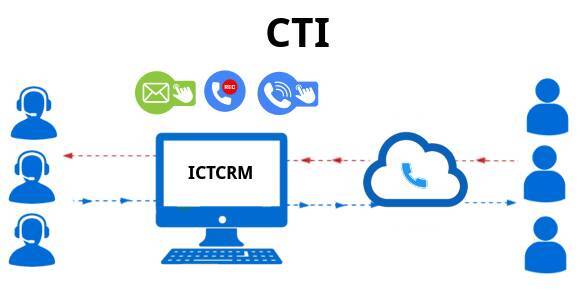Introudction:
In today’s fast-paced and fiercely competitive business landscape, firms recognize the critical importance of customer engagement in achieving success. With technology advancing at breakneck speed, businesses are increasingly adopting open-source Customer Relationship Management (CRM) platforms that seamlessly integrate telephony features. This integration represents a paradigm shift, transforming workflows, enriching customer interactions, and driving revenue growth. In the upcoming piece, we’ll explore the advantages and opportunities of open-source CRM with telephony integration, uncovering its potential to significantly enhance customer engagement.
I. Understanding Open Source CRM
Open source CRM denotes customer relationship management software developed on open source code, enabling users to freely access, modify, and distribute the software. In contrast to proprietary CRM systems, open source CRM solutions offer flexibility, affordability, and a vibrant community of developers and contributors committed to ongoing improvement and innovation.

II. The Significance of Telephony Integration
The integration of telephony into open-source CRM systems is a transformative feature, offering organizations a wealth of empowering capabilities. These include call management, call recording, automated call logging, and a range of other functionalities. By seamlessly merging CRM and telephony, businesses can consolidate their customer data and communication channels into a unified platform. This integration not only enhances efficiency but also promotes collaboration, setting higher standards for customer service excellence. With telephony integration, organizations can streamline operations effectively and provide a seamless, personalized experience for their esteemed customers.
III. Benefits of Open Source CRM with Integrated Telephony
a) Enhanced Customer Service: Integrating telephony into CRM systems empowers customer service teams with real-time access to customer data, enabling personalized support and swift issue resolution. This integration facilitates vital features like call routing, Interactive Voice Response (IVR), and automatic call distribution, ensuring customers are swiftly connected to the right agents for efficient handling of their inquiries. Leveraging integrated telephony, organizations can elevate their customer service capabilities and optimize the overall customer experience.
b) Streamlined Sales Process: Telephony integration enables sales teams to make and receive calls directly within the CRM system, eliminating the need for separate phone systems. This integration simplifies lead management, call tracking, and follow-ups, allowing sales representatives to focus on building relationships with prospects and closing deals.
c) Improved Collaboration: Open source CRM with telephony integration fosters better collaboration among team members. Employees can access call recordings, notes, and call logs, providing comprehensive insights into customer interactions. This shared knowledge base enhances cross-departmental communication and ensures a consistent customer experience throughout the organization.
d) Data-driven Decision Making: By consolidating customer data from telephony and CRM systems, organizations gain valuable insights into customer behavior, preferences, and trends. Analyzing this data helps businesses make informed decisions, optimize marketing strategies, and tailor their products or services to meet customer expectations.
IV. Implementing Open Source CRM with Integrated Telephony
a) Choosing the Right CRM Solution: Selecting an open source CRM solution with telephony integration requires careful consideration. Factors such as scalability, customizability, ease of use, and community support should be evaluated to ensure the chosen CRM system aligns with the organization’s specific needs.
b) Integration and Configuration: Once the CRM system is chosen, proper integration with the telephony infrastructure is crucial. This process involves configuring call routing, mapping fields, and synchronizing data between the CRM and telephony systems. Collaborating with experienced IT professionals or utilizing the expertise of the open source community can streamline the integration process.
c) Training and Adoption: Successful implementation of open source CRM with integrated telephony requires proper training and user adoption. Employees should be trained on how to leverage the CRM’s telephony features effectively, ensuring they can make the most of the system’s capabilities to enhance customer engagement.
V. Case Studies and Success Stories
Illustrating the real-world impact of open source CRM with integrated telephony, this section explores case studies and success stories of organizations that have leveraged this technology to achieve significant improvements in customer engagement, sales performance, and overall business success.
VI. Future Trends and Innovations
As technology continues to advance, the future of open source CRM with integrated telephony looks promising. This section explores emerging trends, such as artificial intelligence-powered voice assistants, sentiment analysis, and omni-channel communication, which have the potential to further revolutionize customer engagement and reshape the CRM landscape.
Conclusion:
Open-source CRM with integrated telephony presents a robust solution for organizations aiming to elevate customer engagement. This fusion of CRM features with telephony capabilities empowers businesses to enhance customer service, streamline sales operations, promote collaboration, and leverage data for informed decision-making. As technology progresses, the integration of open-source CRM with telephony is positioned to become increasingly crucial in enhancing customer engagement and fueling organizational success.
Leveraging Open Source in ICT
TechnologyHQ is a platform about business insights, tech, 4IR, digital transformation, AI, Blockchain, Cybersecurity, and social media for businesses.
We manage social media groups with more than 200,000 members with almost 100% engagement.